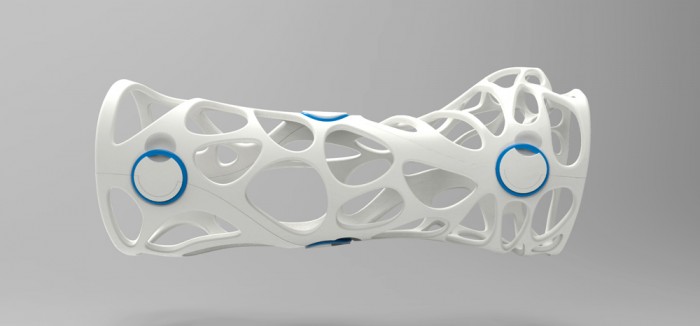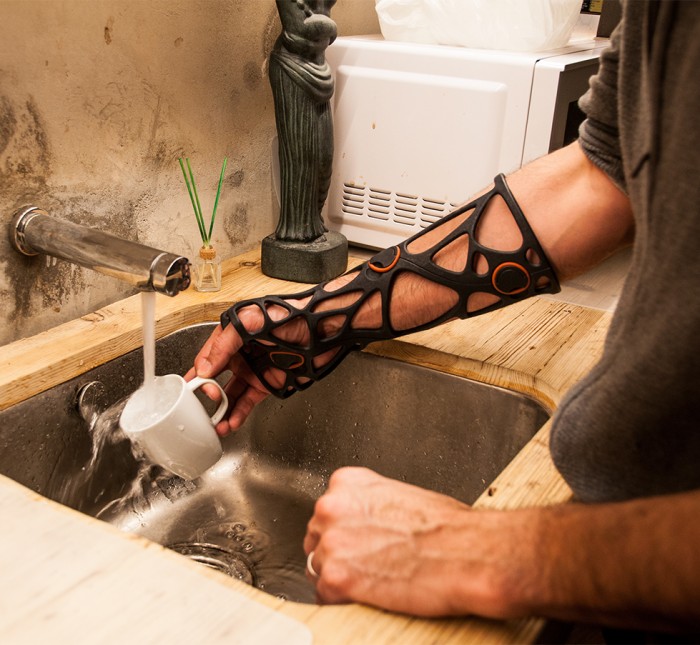You Can Get a 3-D-Printed Cast for a Broken Bone
Every year, some six million people in the United States break a bone, and many of these injuries are cloaked with a heavy sheath of fiberglass or plaster while they heal—a treatment that’s been the same for generations.
But casts are finally getting a modern spin. 3-D-printed casts boast an open-lattice plastic design that’s customized to the individual patient. They’re waterproof, they’re more comfortable, and they may even help the bones heal faster. The casts are part of a larger movement toward personalized 3-D-printed medical devices.
A number of startups around the world are working on this new technology. Earlier this year, engineering student Zaid Musa Badwan founded MediPrint in Mexico to manufacture the NovaCast he and colleagues designed, and a few weeks ago Xkelet, based in Girona, Spain, won a Red Dot Design Award (awarded in a prestigious international design competition) for its cast.
The basic concept is relatively straightforward: a scanner gathers the specifications of the broken limb, and a design software program uses them to build a personalized cast. The cast is printed, often in two pieces, and secured in place until the limb heals.

Printing the cast eliminates the variability of hand molding, and its design—a plastic structure with many round openings—is lightweight and breathable, an obvious improvement in comfort and hygiene.
The openings are also important for another reason: they allow the doctor and patient easy access to the injured limb. Carol Lin, an orthopedic surgeon at Cedars-Sinai Hospital, says this is useful for assessing skin health and re-dressing wounds, which may reduce the number of follow-up visits. She says it’s especially useful for geriatric patients, whose skin is “like tissue paper.” The design also offers doctors the option of easily stimulating the injured area with ultrasound and other technologies, which Lin says can help some bones heal.

None of these 3-D-printed casts are on the market yet, but Xkelet is currently testing its cast on two real patients, and it will start a clinical trial with the CE (Spain’s version of the FDA) in September. It has already secured a contract with two of the four major insurance companies in Spain, and CEO Jordi Tura anticipates that the cast will reach hospitals within six months. He says the casts cost between $200 and $500.
Doctors see 3-D-printed casts as the latest application of a technology that’s already taken hold in medicine. Surgeons use 3-D-printed models of patients’ anatomical features for better surgical planning, and patients are benefiting from custom-printed prostheses, knee replacements, and more. SmarTech Markets projects that the medical market for 3-D printing will balloon from $498 million in 2014 to over $5.8 billion in 2024.
As the price of 3-D printing drops, it will open the door for more applications and offer ways to improve more existing medical products, even those—like casts—that haven’t changed in 50-plus years.
“We accept the limitations of the technology we have now, because that’s what we grew up training with,” says Lin. “And it’s pretty good, but it’s not perfect. We just don’t know how much better it could be yet.”
Update: This story was updated to reflect the correct cost of the Xkelet cast. It is $200-$500.
Keep Reading
Most Popular
Large language models can do jaw-dropping things. But nobody knows exactly why.
And that's a problem. Figuring it out is one of the biggest scientific puzzles of our time and a crucial step towards controlling more powerful future models.
How scientists traced a mysterious covid case back to six toilets
When wastewater surveillance turns into a hunt for a single infected individual, the ethics get tricky.
The problem with plug-in hybrids? Their drivers.
Plug-in hybrids are often sold as a transition to EVs, but new data from Europe shows we’re still underestimating the emissions they produce.
Stay connected
Get the latest updates from
MIT Technology Review
Discover special offers, top stories, upcoming events, and more.